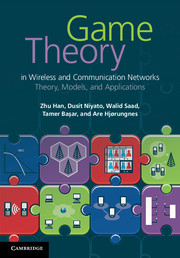2 - Wireless networks: an introduction
Published online by Cambridge University Press: 25 October 2011
Summary
A wireless network refers to a telecommunications network whose interconnections between nodes are implemented without the use of wires. Wireless networks have experienced unprecedented growth over the last few decades, and are expected to continue to evolve in the future. Seamless mobility and coverage ensure that various types of wireless connections can be made anytime, anywhere. In this chapter, we introduce some basic types of wireless networks and provide the reader with some necessary background on state-of-art development.
Wireless networks use electromagnetic waves, such as radio waves, for carrying information. Therefore, their performance is greatly affected by the randomly fluctuating wireless channels. To develop an understanding of channels, in Section 2.1 we will study the radio frequency band first, then the existing wireless channel models used for different network scenarios, and finally the interference channel.
There exist several wireless standards. We describe them according to the order of coverage area, starting with cellular wireless networks. In Section 2.2.1 we provide an overview of the key elements and technologies of the third-generation wireless cellular network standards. In particular, we discuss WCDMA, CDMA2000, TD/S CDMA, and 4G and beyond. WiMax, based on the IEEE 802.16 standard for wireless metropolitan area networks, is discussed in Section 2.2.2. A wireless local area network (WLAN) is a network in which a mobile user can connect to a local area network through a wireless connection.
Information
- Type
- Chapter
- Information
- Game Theory in Wireless and Communication NetworksTheory, Models, and Applications, pp. 14 - 52Publisher: Cambridge University PressPrint publication year: 2011
Accessibility standard: Unknown
Why this information is here
This section outlines the accessibility features of this content - including support for screen readers, full keyboard navigation and high-contrast display options. This may not be relevant for you.Accessibility Information
- 1
- Cited by
